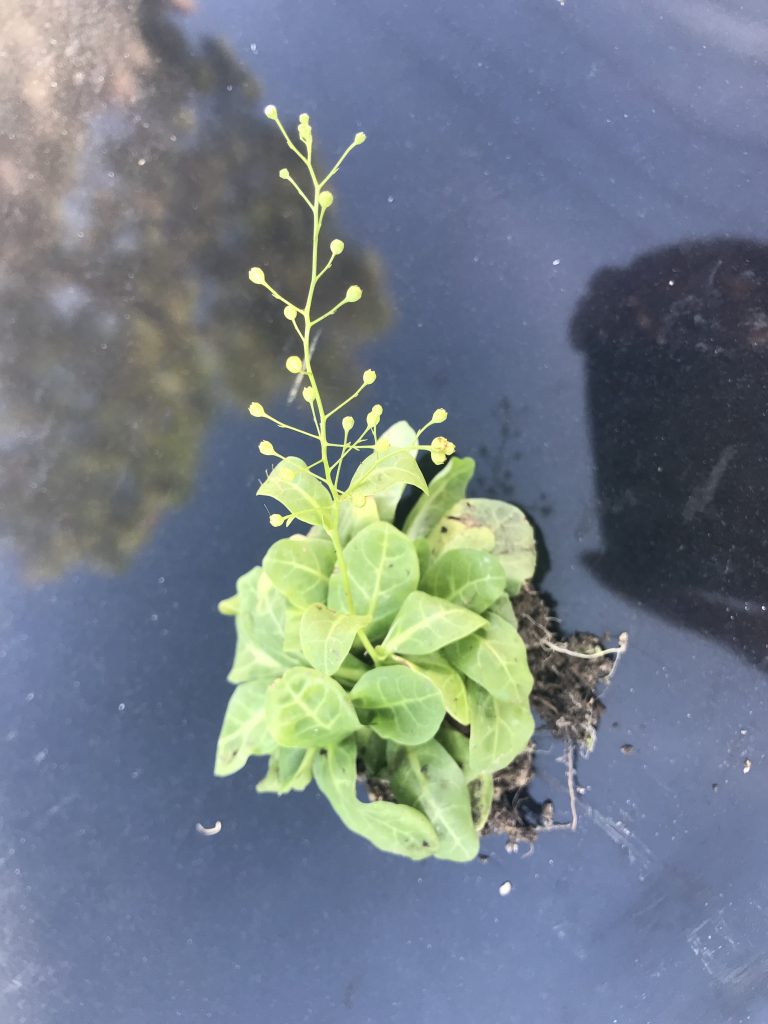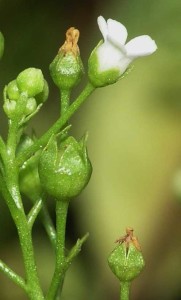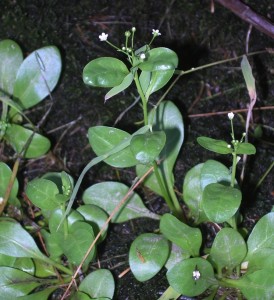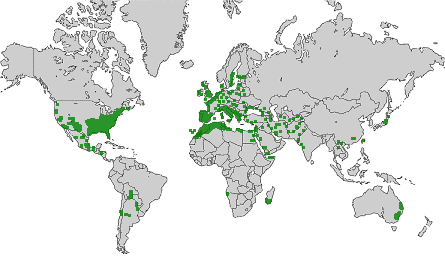
Brookweed salad ingredient and source of vitamin C. Photo by Green Deane
Brookweed is an edible plant few know a lot about these days. Even Professor Daniel Austin, who managed to write 909 pages about ethnobotany, could only scrape up one paragraph.

Petals fuse part way down. Photo by Jan De Laet
Moerman does not mention the Brookweed in his book on Native American Food Plants. It escaped entry in Cornucopia II, the Encyclopedia of Edible Plants of North America, and Edible Wild Plants, the latter by Fernald who included some mighty off-beat species in his book such as Montropa uniflora, the Indian Pipes. Brookweed also managed to not be mentioned in the Journal of Economic Botany during the last 60 or so years. Most references skip over the genus (Samolus) going from Sambucus to Sassafras which is admittedly quite tempting. On the positive side the plant is also not mentioned in Plants that Poison People by Morton, Plants That Poison by Schmutz nor in the mystery writers’ bible Poisonous Plants of the United States and Canada by Kingbury. Here’s Austin’s entry from page 596 of his book Florida Ethnobotany:
“This is another medical plant that Hogan (1978) found at the pre-Columbian Glades village at Ft. Center. Here, however, apparently is the only record of indigenous use of the plants in North America. Nearby in Cuba, Samolus is considered antiscorbutic and diaphoretic and is sometimes eaten in salads or as emergency food. (Roig 1945). Although no use is given for Samolus, its Huastec name associates it with an edible plant, suggesting that it, too, was eaten (Alcorn 1984.)”

Low-growing in wet spots. Photo by Bruce Patterson, New England Wildflower Society.
Brookweed, Samolus valerandi, has some history as an edible in Europe (as old books say it is found in the Old and the New World and even in Australia.) It grows in watery conditions and can tolerate some salinity. At least one related species tolerates high salinity. Young leaves are soft, spinach-like. When very young the leaves are bland but quickly develop a bitter flavor, which might explain their absence from the dinner menu but found in the home pharmacy. Like many such greens they were tossed into salads with a lot of other greens. In Catalonia, for example, it is a very common salad addition usually with two to three other greens. When cooked they are used the same way, an addition to not the main flavor of. In parts of Africa it is famine food, that is, eaten when preferred food is not available.
Medicinally S. valerandi has been used as an astringent, a laxative and for scurvy so we know it has some ascorbic acid (vitamin C) but we don’t know how much. A 2004 publication, Plant Resources of Tropical Africa 2, states the plant’s nutritional and medicinal properties need to be researched. Brookweed was also often used to heal wounds, rashes, chaps, and ringworm. Close relatives, the Pimpernels, were used for dropsy, epilepsy even rabies. Locally Wunderlin enumerates two Samolus in Florida, S. valerandi subsp. paraviflorus, aka S. floribundus, and S. ebracteatus also called the Limewater Brookweed. Interestingly the word “brookweed” has been around in English since at least 1624. As Florida is wet and there aren’t that many brooks the name “Pineland Pimpernel” is as good as any other.
There are about a dozen species in the Samolus genus and there is a bit of a debate on what the genus name means. It could be from the Gaelic meaning “ointment” or “plant salve.” Other translations include “Good Pig,” “Healthy Pig,” and “Pig Food.” Or Samulos might be Dead Latin for some plant the Druids used for pig medicine. Pliny the Elder reported that in the first century. Perhaps the Druid/Gaelic words came first and the Dead Latin is only echoing that use. Pliny also reported there were superstitions associated with the plant and that was used as medicine for cattle. It was harvested only while fasting, only with the left hand, and was not put anywhere “other than the trough where it is crushed.” Translations vary but what he wrote was: “Druidae Samolum herbam nominavere – hanc et sinistra manufactory legiti a jejunis counter morbos sum boumque, ne respicere legentem -” The Druids believed Brookweed could make one invisible. (Apparenlty the conquering Romans did not believe that.) Because of the plant’s common name back then some early botanists thought the plant was from the Greek island of Samos. That’s probably not true but inhabitants there did make vases that resemble the plant’s leaf shape, and the plant is common on Crete.
Valerandi is also from Dead Latin and means “full of strength.” The species was named after 16th century botanist Valerand Dourez of Lyon. An early publication, the Journal of British and Foreign Botanists, says Dourez was born in Lille, Flanders, and might have been related by marriage to the more famous botanist Johann Bauhin for whom Bauhinia is named. Though a botanist Dourez leaned towards the chemistry side. Today we would call him a pharmacist. His botanical travels included going to the Alps, Greece and Syria. In 1565 he married in Lyon then died there between 1571-75. Samolus (Samole in French) was a tribute to Dourez by his French botanists friends. And there is also some disagreement whether his name is Valerand Dourez or Dourez Valerand. I think this can be traced to a Victorian illustrator named Anne Platt (1806-1893) who wrote and illustrated over 200 books. Though publicly very popular she was never accepted by the Good-Old-Boy botanists because

A later photograph of Anne Platt. To read about the Victorian’s Language of Flowers click here.
she was self-taught. In 1855 she wrote Flowering Plants of Great Britain and mentions Dourez in Volume 3 page 52. Later she repeats herself (posthumously) on page 79 in an 1899 book called Flowering Plants, Grasses, Sedges, and Ferns of Great Britain. It seems Platt is the first one to switch the names in print calling him Dourez Valerand. Unfortunately a 1985 book copied the mistake. Platt also reported that some earlier authors thought Dourez (rather than the plant) was from Samos. That is how someone who was born in Belgium and lived in France becomes on the internet a Greek from Samos with a reversed name.
Ebracteatus means without bracts, parviflorus means small leaf. Samolus in English is said SA-moe-lus or SAM-uh-lus. Valerandi is said va-LAIR-ann-dee though some might be tempted to say val-er-ANN-dee. Common names in English are the Pineland Pimpernel, Water Pimpernel, Water Chickweed, Seaside Brookweed (the name the USDA prefers) Salt Bunge, Water Rose, Water Cabbage, Florida Limewater Brookweed, and Kenningwort, the latter a rare use meaning “ulcer plant.” There is some speculation that Shakespeare mentioned it in Midsummers Night’s Dream when referencing “Dian’s Bud.” The Germans call it Samoskraut, Dutch Strandpungen and the Danes Strandsamel.
Green Deane’s Itemized Plant Profile: Brookweed
IDENTIFICATION: Samolus valerandi, low to short, creeping perennial; stems branched or unbranched, erect, light-veined leaves a basal rosette of oval, alternate along the stem. White blossoms, cup-shaped, stalked, borne in lax racemes; five petals joined at half way. S. ebracteustus does not have any bracts, flowers are 5-7 mm wide, stem leaves do not extend into the inflorescence. S. valerandi has minute bracts near the middle of the pedicle, the stem leaves extend into the inflorescence, blossoms are 2-3 mm wide. Grows eight to 10 inches high. Now in their own family, Samolaceae.
TIME OF YEAR: Flowers May to September depending on climate, young leaves when present. Small pods ripen, darken then turn brown.
ENVIRONMENT: Slow growing. Watery places, wet grasslands, edges of streams, ditches, can thrive in salty conditions. Given a choice it likes to grow on wet gravel. Can reproduce by seeds or by leaf bud. Some report it is difficult to grow. Can grow submerged. The plant’s habitat is diminishing in France and in some areas is protected.
METHOD OF PREPARATION: Young leaves raw or cooked.
Special thanks to Josey for some information used.



